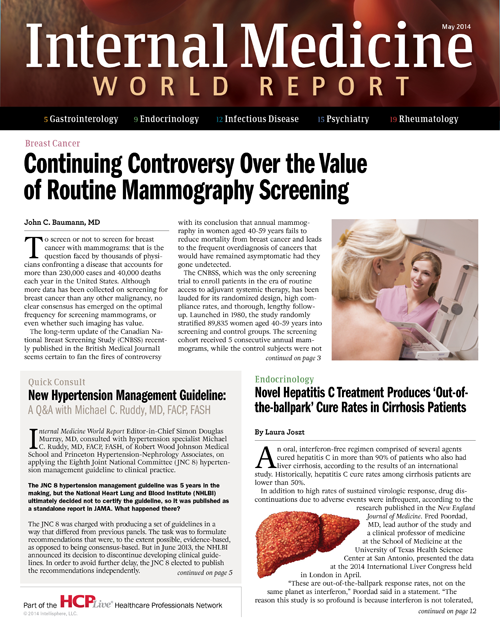Publication
Article
Internal Medicine World Report
New Hypertension Management Guideline: A Q&A with Michael C. Ruddy, MD, FACP, FASH
Michael C. Ruddy, MD, FACP, FASH, describes the clinical applications of the Eighth Joint National Committee (JNC 8) hypertension management guideline.
Internal Medicine World Report Editor-in-Chief Simon Douglas Murray, MD, consulted with hypertension specialist Michael C. Ruddy, MD, FACP, FASH, of Robert Wood Johnson Medical School and Princeton Hypertension-Nephrology Associates, on applying the Eighth Joint National Committee (JNC 8) hypertension management guideline to clinical practice.
The JNC 8 hypertension management guideline was 5 years in the making, but the National Heart Lung and Blood Institute (NHLBI) ultimately decided not to certify the guideline, so it was published as a standalone report in JAMA. What happened there?

The JNC 8 was charged with producing a set of guidelines in a way that differed from previous panels. The task was to formulate recommendations that were, to the extent possible, evidence-based, as opposed to being consensus-based. But in June 2013, the NHLBI announced its decision to discontinue developing clinical guidelines. In order to avoid further delay, the JNC 8 elected to publish the recommendations independently.
What questions did the JNC 8 address?
The panel started the process by developing a consensus around the 3 most critical questions facing primary care physicians (PCPs) in the evaluation and management of high blood pressure (BP):
1. At what BP level does the risk of drug therapy exceed the benefit for adverse cardiovascular (CV) and renal health outcomes?
2. What is the goal BP to which we should aim?
3. How do we accomplish this with medication?
The panel also went through a lengthy process to evaluate and develop a predefined and rigorous set of evidence-based criteria for the recommendations. At the highest level were multicenter, randomized controlled trials (RCTs) of more than 2,000 adult hypertensive participants. All studies required outcome data for at least one or more of the following: mortality — including all-cause, CV-related, and linked to chronic kidney disease (CKD) — or serious CV or renal events.
Data from some well-conducted studies that did not meet all of these criteria were considered and consensus opinion was incorporated to fill in several gaps for which there was insufficient information. These instances led to explicit strength grading of each recommendation contained in the final report published in JAMA.
What were the panel’s key recommendations?
In the final report, there were 9 total recommendations, the first 5 of which were directed at the first question concerning the goal BP level:
1. For those aged ≥60 years, aim for <150/90. For patients already on well-tolerated therapy with BP under that range, it is ok to continue such therapy.
2. In patients aged <60, aim for diastolic blood pressure (DBP) <90 mmHg
3. In patients aged <60, aim for systolic blood pressure (SBP) <140 mmHg
4. In patients with CKD aged <70 years, aim for <140/90
5. In patients with diabetes mellitus, aim for <140/90
Recommendations 6-8 pertained to choosing an antihypertensive agent:
6. In the non-black population, start with any thiazide diuretic, calcium channel blocker (CCB), or angiotensin-converting-enzyme (ACE) inhibitor
7. In the general black population, initiate thiazide or CCB
8. In the CKD population, include one renin inhibitor
The final recommendation describes how to titrate the medications for those who do not respond adequately.
9. If target BP is not achieved after one month, either increase the dose or add a second and third drug from the initial list of thiazide diuretics, CCBs, and renin antagonists. If more than 3 agents are required, then an agent from another class — including beta-blockers, non-thiazide diuretics, alpha-blockers, vasodilators, and central nervous system (CNS)-acting agents — may be added.
What is the controversy surrounding the target BP in the elderly?
The most controversial of the 9 recommendations is the first one, which suggests the target BP in those aged 60 years and older should be raised from the longstanding 140/90 to 150/90. The JNC 8 authors provided an extensive rationale based on the experimental design and findings of several large-scale RCTs, including the Systolic Hypertension in the Elderly Program (SHEP) and the Systolic Hypertension in Europe (Syst-Eur) trials. These studies had previously been interpreted as suggesting a benefit from a BP treatment target of <140/90, but as the JNC 8 panel correctly indicated, the targeted and achieved SBP levels reported in most of these studies actually fell between 140-150 mmHg.
A group of 7 panel members of the JNC 8 published a minority report in the January 2014 issue of the Annals of Internal Medicine outlining evidence in support of the stricter SBP target of <140 mmHg for those aged 60 years and older. The authors cited several relevant and well-conducted RCTs and observational studies that supported the lower BP target but did not fulfill all of the criteria set by the full panel. They expressed concern that less rigorous SBP targets for this age group might lead to laxity among physicians in overall BP management, and they pointed to other recent hypertension guidelines in which the higher BP target of <150/90 was applied only to those aged 80 years and older.
How successful was the JNC 8 in simplifying BP treatment?
An important goal for JNC 8 was to make recommendations that are rigorously evidence-based while being practical, and in that, they appear to have been successful. BP targets have been simplified and virtually all patients under the age of 60 — including those with diabetes and CKD — now have the same therapeutic BP goal of <140/90. We are also down to 3 drug classes with which to initiate therapy, and we have a fairly simple algorithm for drug choice and dose titration.
Where does beta-blocker therapy fit into the guideline?
Over the years, it has been interesting to watch the pendulum swing on beta-blockers. In a number of placebo-controlled RCTs that demonstrated risk reduction from drug therapy, such as the SHEP trial, beta-blockers were incorporated as add-on, second-line therapy in the intervention groups. Yet, in later studies that compared risk reduction across different drug classes, the beta-blocker treatment groups did not fare as well as the angiotensin II receptor blocker (ARB) and CCB ones.
Application of its own evidence-based criteria required the JNC 8 to remove beta-blockers from the list of first-line agents. However, it is very important to acknowledge that beta-blockers still have a critically important therapeutic role for a large number of hypertensive patients. These agents are central to the treatment of many cardiac disorders to which hypertensives are predisposed, such as coronary artery disease (CAD), left ventricular dysfunction (LVD), and various arrhythmias. Furthermore, younger hypertensive patients who may have a greater adrenergic component to their BP elevation may benefit from a beta-blocker as initial therapy.
Treatment guidelines were initially developed to serve as roadmaps for physicians, but in recent times, they have been used to set standards of care that must be met under the threat of penalties like insurance quality reviews and potential malpractice ramifications.Does the JNC 8 guideline give PCPs enough “wiggle room” to individualize treatments for different patients?
It is important to underscore the point that the JNC 8 report remains fully compatible with and, indeed, highlights that individual patients have variable needs and responses, thereby allowing for considerable therapeutic flexibility. Clinical guidelines such as these are designed to serve as an overview and advice for clinicians in helping patients reduce their risk of adverse outcomes. These are certainly not mandates, so in my view, it would not be appropriate to utilize them for physician pay for performance, quality review, or medical-legal purposes.
Do you recommend home BP monitoring? If so, how do you instruct patients to do it?
Home BP monitoring was not specifically addressed within the relatively narrow focus of the JNC 8 report. Nevertheless, home BP measurements can be of tremendous help in patient evaluation and management, so I usually advise patients to measure and record BP and HR twice daily for the immediate 7 days before each office visit. These data can help us screen for white coat and masked hypertension, correlate symptoms with BP levels, and provide valuable feedback for treatment compliance and timing of drug administration.






